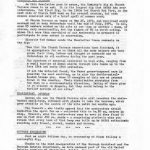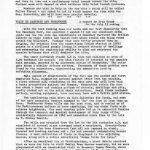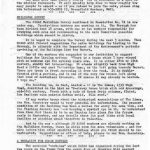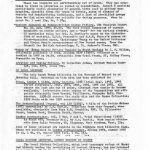Page 1
Thanking all diggers
As this Newsletter goes to press, the Society’s dig at Church Terrace comes to an end. It is the longest dig that HADAS has ever undertaken. Our first dig, in the 1960s (at Church End Farm, on the west side of Church End) went on for several seasons, but each season consisted only of a brief spell of summer work.
At Church Terrace we began on 26 May 1973, and continued every weekend and on many Wednesdays until the end of July 1974. In all, some 85 members worked on the site at one time or another — many, of course, only occasionally, but the figure of 85 is worth noting. It shows that more than 1/3 of are membership is prepared to participate to some extent in excavation.
Director Ted Sammes sends the Newsletter these comments on the dig:
“Now that the Church Terrace excavations have finished, it is appropriate for me to thank all the many helpers who have given their time, labour and thought at weekends and on Wednesdays in all weathers during the past year.
The spectrum of material recovered is very wide, ranging from a small scatter of Roman sherds through late Saxon up to the late eighteenth and early nineteenth centuries.
Of all the material found, the Saxon grass-tempered ware is possibly the most exciting, as is also the double-spiral-headed bronze pin. Some 18 examples of this are at present known in the country. Their distribution stretches from the Wash in a south-westerly direction. Dating of these pins is at present in dispute, but they could belong to the earlier periods of our site.”
Statistical footnote
Anyone who saw the Church Terrace site will remember the whale-backed spoil-heap, ribboned with planks to take the barrows, which grew steadily in the centre of the site until two months ago.
The Council — who kindly agreed that the contractors should back-fill the spoil heap for us — estimated this to be 18 cubic metres in size. However, when the contractors came to move it they found it was in fact over 200 cubic yards — a surprising statistic when you recall that every inch of that heap was built up by HADAS enthusiasts wielding only trowel, shovel, bucket and barrow.
Pottery Processing
Just as night follows day, so processing of finds follows a successful dig.
Thanks to the kind co-operation of the Borough Architect and the Borough Estates Department, we have secured part of the old United Dairies premises at Church End, Hendon, for use as a processing workshop. This is the area immediately behind the present PDSA shop on the corner of Church Road and Church Terrace.
Here pottery sorting, washing and marking will continue. It is hoped to start the workshop in the weekend of August 10-11. Members prepared to help can obtain further details nearer the time from Paddy Musgrove.
Page 2
Future Digging
As mentioned in Newsletter No. 40, HADAS applied for other sites in the Church End Hendon development. The Borough has now kindly confirmed that next site will be in the area bounded on one side by Church Road and on two others by a Fuller Street and Sunny Gardens Road. The huts have already been moved to the new site.
It is hoped to grid the area in the weekend of August 31st/September 1st, and then to take out a preliminary trial trench across the site. Further work will depend on what evidence this trial trench produces.
Members who wish to help on the new site — which will be called Fuller Street — are asked to get in touch nearer the time with the Hon. Secretary, who will have more precise details.
Visit to Danebury and Rockbourne
A report by Eric Grant on the July 13th outing.
With the rain running down our necks and our feet dissolving into the Danebury turf, the question I wanted to ask our excellent site-guide was how the Iron Age inhabitants of Danebury survived the British climate in their timber and thatch huts whose traces are being found within the hill-fort. Perhaps they were better prepared than we imagine, for evidence from the excavations (which started in 1969) points to a civilised people living in ordered streets of dwellings and possessing the engineering ability to plan and construct the massive defences that still dominate the site.
The inner earthwork stands 3.5 metres high and encloses an area of 5.25 hectares (13 acres); its main feature of interest is the massive main gateway, guarded by an elaborate series of hornworks. The outer main gate shows a similar defence pattern. Thousands of beach pebbles were found by the excavators, representing the ammunition used by defending slingsmen.
The main period of construction of the fort was the second and first century BC, suggesting defence against other Iron Age peoples. A first century AD rebuilding of the main gate may well have been a hasty preparation against the Romans. Excavation within the Fort has shown a dense and complex pattern of streets, dwellings and pits, neatly picked out on the solid chalk sub-surface. Small finds included pottery, weaving equipment, iron currency bars and a Celtic gold stater.
The unrelenting rain drove us into Salisbury for lunch, and some of the more energetic members managed to “do” the town in less than an hour. Rockbourne Roman Villa was next stop, and to remind us of the Mediterranean culture we were examining, the sun shone forth with welcome brightness. Our west country guide led us in unhurried fashion through the temporal and spatial development of this large villa, accidentally discovered in 1943 and excavated since then by the late A. T. Morley Hewitt.
The villa was occupied from the 1st to the 5th centuries AD and consisted of several wings arranged round a courtyard. 73 rooms have so far been discovered (not all are exposed to view). Several had heating systems and a few had somewhat uninspiring mosaic floors. A vast collection of finds is displayed in the adjoining Museum, along with a notice advertising “Roman Coins for sale”.
After an excellent tea at Fordingbridge, a short debate resolved that we were too late to visit Oakley Down Barrow cemetery, but we were compensated with an unscheduled visit to Breamore Saxon Church, Where Ted Sammes’ careful guidance made us oblivious of the heavy rain.
On our return journey through the incipient industrial archaeology of the unfinished M3 we thanked Ann and Colin Evans for the thorough but unobtrusive organisation of the programme, while Dorothy Newbury, tireless as always, was again able to improve the Society’s funds by means of an impromptu raffle.
Page 3
A date for your diary in SEMI DETACHED EDGWARE
Alec Jeakins will lead a walk around this area on Saturday 17 August. Meet in the forecourt of Edgware Underground Station at 2.30p.m.
The itinerary will be based on a walk organised by the Victorian Society last April. It will consist of a tour of various types of suburban development – Canons Park, Edgware Manor Estate and the shops, offices, etc., that make up this 50-year-old suburb.
The walk will take about two hours. Tea is available in a cafe in the station forecourt. It will greatly help Alec to know roughly how many people to expect — so if you intend to join the walk, please ring him beforehand.
Building Survey
The HADAS buildings survey mentioned in Newsletter No. 41 is now under way in. 23 members are working on it. The Borough has been divided into eighteen areas, with one or two members responsible for studying each area and recommending to the main Committee possible buildings which should be listed.
It is hoped to complete the survey during the next three months. Then HADAS will forward suggestions for extra buildings for Listing to the Borough, to coincide with the Department of the Environment’s periodic up-dating of the Buildings List for Barnet.
One of the members who responded to our invitation to suggest buildings for listing writes: “There is a house which I have viewed with an anxious eye for several years now. It is either eighteenth or nineteenth century, shabby but interesting. It stands slightly back from the High Road a little way past Totteridge Lane, on the left going towards Barnet. There are trees in front screening it from the road. It is double-fronted with a portico, and is one of the very few houses left along that road of historical interest. Of course it may already be Listed. I hope so.”
The building is, in fact, Listed — it is The Limes, 1339 High Road, described in the List as “2-storey brown brick with red dressings, mid-eighteenth century. Porch with a pair of Greek Doric columns, fluted. The low fanlight with pointed in Gothic motif. Tile roof”.
If any member knows about the historical associations of The Limes, the Hon. Secretary would be very grateful for information. The present condition of the building has been a matter for worry for some time, and the Finchley Society has been keeping a special eye on it. We understand from them that there is to be an Enquiry into plans for its future early in September, and any details about past links with local families or notables would therefore be valuable.
And by the way — although 23 HADAS members are already working on the building survey, there is still room for more volunteers — and for more information about specific buildings which you think should be investigated. Suggestions or offers of help please to our Hon. Secretary.
A book-list for Roman Pottery
The weekend “work-ins” which HADAS has organised during the last few years on the finds from the early digs at Brockley Hill suggest that members interested in Roman Pottery might well find it useful to have a brief bibliography on the subject.
The following list is far from exhaustive, but it may serve as a starting point for those who want to go more deeply into this particular aspect of archaeology.
Page 4
GENERAL
THE ARCHAEOLOGY OF ROMAN BRITAIN, R. G. Collingwood and Ian Richmond, revised edition, 1969, Methuen, £5.00.
This contains a rather general account of Roman Coarse Pottery and a chapter by B. R. Hartley on Samian Ware or Terra Sigillata”. This reassessment of Samian is particularly important, so much so that the chapter has also been published as a separate pamphlet by the Herts Archaeological Society (price £0.30).
STRUCTURE OF ROMANO-BRITISH POTTERY KILNS — CBA Research Report 5
ROMANO-BRITISH COARSE POTTERY — a student’s guide, CBA Research Report 6
These two booklets on unfortunately out of print. They can sometimes be found in libraries or picked up second-hand. Report 6 contains particularly useful glossaries of general terms used in pottery description, specific terms for types of fabric, names of classes of vessels and manufacturing techniques, and a list of stratified groups from British sites which are reliable for dating purposes. When in print No. 5 costs £0.15, No. 6 £0.28.
CURRENT RESEARCH IN A ROMANO-BRITISH COARSE POTTERY CBA Research Report No. 10 pub. 1973, £4.00.
The most recent symposium of current knowledge on coarse pottery, and a “must” for any serious student. Of particular value Mrs. K. Hartley’s paper on the distribution of mortaria, D. P. S. Peacock’s and R. A. H. Farrar’s papers on black-burnished wares, Christopher Young on the Oxford Potteries and Vivien Swan’s reassessment of New Forest wares. From the Council for British Archaeology, 8, St. Andrew’s Place, NW1.
TYPES OF ROMAN COARSE POTTERY VESSELS IN NORTH BRITAIN by J. P. Gwilliam, originally published in Arch. Aeliana XXXV (1957), and reissued as a booklet in 1968 at 7/6d, obtainable from Oriel Press, 27, Risley Place, Newcastle upon Tyne.
ARRRETINE AND SAMIAN POTTERY by Catherine Johns, British Museum booklet, pub. 1971, price 40p.
Of Local Interest
The only known Roman kiln-site in the Borough of Barnet is at Brockley Hill. Material on this site has been published in:
TRANS. LONDON & MIDDX. ARCH. SOCIETY, 1938 (trial dig), 1948, 1949 (brief reference), 1952, 1953, 1954, 1955, 1956 and 1972. All except the last part out of print, although rare copies do become available. Information about copies of the Transactions and off-prints are attainable from Messrs. Phillimore, Shopwyke Hall, Chichester. 1938-56 concern the early digs and the Moxom Collection; 1972 deals with the 1970 excavations.
THE ARCHAEOLOGICAL JOURNAL, VOL. 129 (1972), a Kiln of the Potter Doinus (1971 excavation) by S. A. Castle. Off-prints from this Journal, when available, obtainable from Miss W. E. Franklin, MBE.
LONDON ARCHAEOLOGIST, Vol. 2 Nos. 2 and 4, Trial Excavations (1972) in field 410, Brockley Hill, by S. A. Castle. Back copies obtainable from Sally Petchey, at 15p.
Also of local interest are reports on the Highgate Wood kiln-site digs. These are published in London Archaeologist, Spring 1969, Summer 1970 (vol. 1 No. 7), Winter 1971 (Vol. 1 No. 13).
Local History Archives, London Borough of Barnet
The Local History Collection, which took temporary refuge at Burnt Oak Library during the rebuilding of Central library, has now returned to occupy the first floor of the Hendon Catholic Social Centre, Egerton Gardens, NW4. All the Hendon local history material is there; but for the time being Finchley material remains at Finchley Central Library. A little Barnet material is at Chipping Barnet Library, but the main of material for Barnet stays at Herts County Record Office, County Hall, Hertford.
Members who wish to consult archives at Egerton Gardens are asked first to ring the Reference Library for an appointment.





